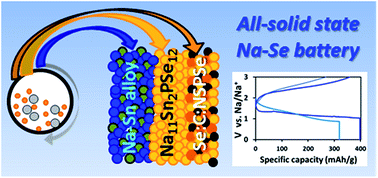Mechanochemical synthesis of fast sodium ion conductor Na11Sn2PSe12 enables first sodium–selenium all-solid-state battery†
Abstract
Fast sodium ion conducting Na11Sn2PSe12 solid electrolyte was prepared by a mechanochemical method. This is the first tin based selenide prepared by room temperature ball milling instead of conventional synthesis in a sealed quartz tube under vacuum. Our approach is safe and easy to scale up. Samples were synthesized systematically using various intervals of ball milling and annealing time to maximise phase purity and ionic conductivity. The highest room temperature bulk ionic conductivity of the mechanochemically synthesized Na11Sn2PSe12 was 1.0 mS cm−1 observed for a sample prepared by ball milling for 15 h followed by 6 h annealing at 550 °C. This fast-ion conducting Na11Sn2PSe12 allowed to demonstrate the first Na–Se all-solid-state batteries Na/Na11Sn2PSe12/C–Se and Na3Sn/Na11Sn2PSe12/C–Se with specific initial discharge capacities of 430 mA h g−1 or 400 mA h g−1, respectively at a current density 0.08 mA cm−2. The Na3Sn/Na11Sn2PSe12/C–Se battery could be cycled 500 times with a capacity that decreased gradually to 50 mA h g−1.



 Please wait while we load your content...
Please wait while we load your content...